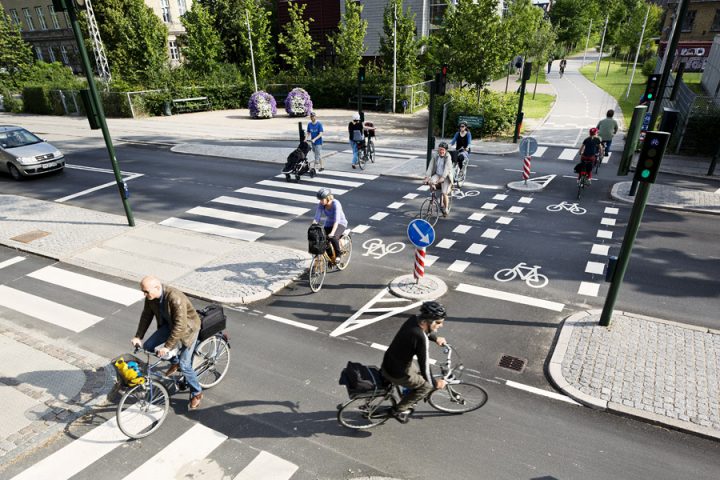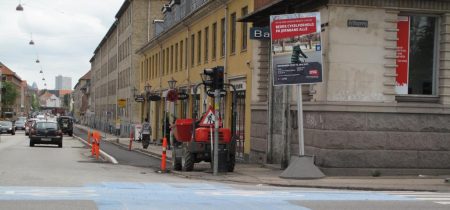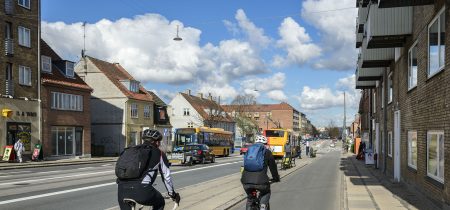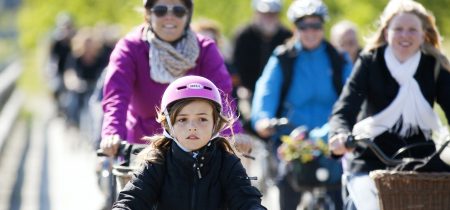Bicycle planning is a joint affair
Bicycle planning is a potential tool for creating synergy and achieving the local authority’s different aims and visions. Inter-departmental cooperation on bicycle planning simply makes sense.
By Maja Sig Vestergaard and Trine Bunton, Rambøll
Over the past decade local authorities have increasingly focused on cycling promotion and bicycle planning. This has been enthusiastically backed up by the municipal administrations, and thanks to them bicycle planning has become a key element in municipal planning and budgeting.
Advantages of cycling
- Climate and the environment: Bicycles do not pollute the environment or make noise as do other transport modes.
- Economy: Investing in cycling promotion is often cheaper than investing in motor traffic. In addition, bicycles are cheaper to use than any other transport mode.
- Less congestion: When more people bike, there’s more space on the roads for the people who have to drive.
- Often better traffic safety: New cycle tracks and bicycle tunnels usually mean enhanced traffic safety.
- Better mobility: Citizens with no access to a car have a greater action radius and greater freedom.
- Better road safety skills for children and young people: When children and young people cycle, they become better road users.
- Health benefits: Cycling is healthy – which benefits the individual as well as public health costs.
- Social benefits: When people cycle, their mental health improves too, and they engage more easily in social interaction.
At the same time citizens and the press have become increasingly interested in bicycle planning, and the message is clear. Citizens want more and better cycle tracks, and there are many positive stories in the daily press about initiatives that promote cycling. Fair winds are blowing for bicycle planning from several directions.
The increased interest has been supported by the national Bike pool, which since 2009 has allocated state funds to subsidize cycling promotion on state and municipal roads. The projects funded by the Bike pool have been far ranging, from the ambitious, major construction of cycle superhighways to small, local educational campaigns at local schools and villages.
What the Bike pool projects have in common is that in one way or another they all support the local authorities’ different agendas and visions.
Examples of projects that received Bike pool funding
Cycle track in Grejsdalen, Vejle municipality
4 km long one-way cycle track on each side of Grejsdalsvej, which is a narrow, winding, and relatively heavily trafficked road. Grejsdal School is on the cycle track. Vejle municipality received DKK 2.6 million in subsidies for the DKK 10.4 million cycle track. The number of cycling school children increased by 48%, although the objective was 30%. For further information see the Bike pool’s evaluation report 2013.
Cycling city project: Horsens cycling city – A wheel ahead
The “Horsens cycling city” project included construction of cycle tracks and cycle lanes, physical improvements and educational campaigns at schools, and establishing shunts and narrow edge lanes in the city of Horsens. The outcome was that two schools had more self-transporting children, there were 17% more cyclists on Amaliegade-Sundvej, and a there was a significant increase in the city of Horsens’ cyclist security and satisfaction. For further information see the Bike pool’s evaluation report 2014.
Development project: School children cycle in Furesø (Folkeskolen cykler i Furesø)
The project aimed at developing and testing a course at Lyngholmsskole and Solvangsskole in Farum, Furesø municipality that focused on cycling. Teaching materials were drawn up that could be used in all schools. The project got more students to cycle to both schools, and both students and teachers considered it a success. The price was approx. DKK 1 million. The project received 100% in subsidies. For further information see the Bike Pool’s evaluation report 2014.
Company mobility plan: Rambøll
When the Rambøll company moved its headquarters to Ørestaden, it needed a mobility plan. The aim was to integrate green transport as a natural, easy and attractive part of everyday company culture, both to and from work and as work related transport. Subsidy: DKK 120,000. The total cost of the Rambøll mobility plan was approx. DKK 0.5 million. For further information see the Bike pool’s evaluation report 2013.
Cycling is relevant for the entire municipal administration
For many years bicycle traffic planning was part of a technical administration, and was considered road and traffic planning. The starting point of bicycle planning, especially in the smaller municipalities, was a cycle track plan, the municipal plan, or a project to improve school safety or general traffic safety.
However, planners have become increasingly aware that there are so many advantages to cycling that it can and should be integrated across the different administrations. The potential of cycling should be exploited as fully as possible to achieve the local authority’s various aims, and of course to get more people to cycle.
Examples of municipal aims that can be boosted by cycling:
- Increased integration: Experience shows that cycling courses and the freedom provided by cycling can boost refugee and immigrant integration. Herning municipality’s project “Women bike” is an example.
- Quality of life for the elderly: If senior citizens can’t cycle themselves, a rickshaw trip and wind in their can make a difference for their quality of life. For further information on Cycling without age see: https://cyclingwithoutage.ca/
- Increased tourism: Denmark is a popular cycling country. Bicycle tourism is a growing trend and has the potential for greater growth. For further information on bicycle tourism in Denmark see The Danish Road Directorate’s annual report 2018.
- Better urban environment: When more people cycle there are fewer emissions and less noise. The Danish Ministry of Transport discusses the cost-benefit gains of reducing traffic noise in Arbejdspapir 3: Cyklingen effecter og samfundsøkonomi (Cycling: Effects and cost-benefit) :https://www.trm.dk/da/temaer/ny-cykelstrategi-2013/arbejdspapirer-og-arbejdsgruppe]
- Better health: When the aim is to encourage people to be more active in their everyday lives, it is obvious that this can be done by biking to and from work, schools, leisure activities, shopping, etc. The Danish Cyclists’ Federation’s educational campaigns (All kids bike and We bike to work) are excellent examples of campaigns which have encouraged more people to use their bikes for daily transport.
- Boost collective traffic: Better cycling conditions, for example attractive bicycle parking facilities, help boost collective transport for users who don’t live within walking distance to a bus stop or train station. Movia has drawn up a guide to good bicycle parking facilities at stations.
- Exercise in primary schools: Transport during school hours can be done by bike, which means students get exercise and save money on transport at the same time, and traffic safety education gets a boost. The fact that physical activity strengthens students’ concentration for about four ours is an extra bonus, as documented in Masseeksperiment 2012.
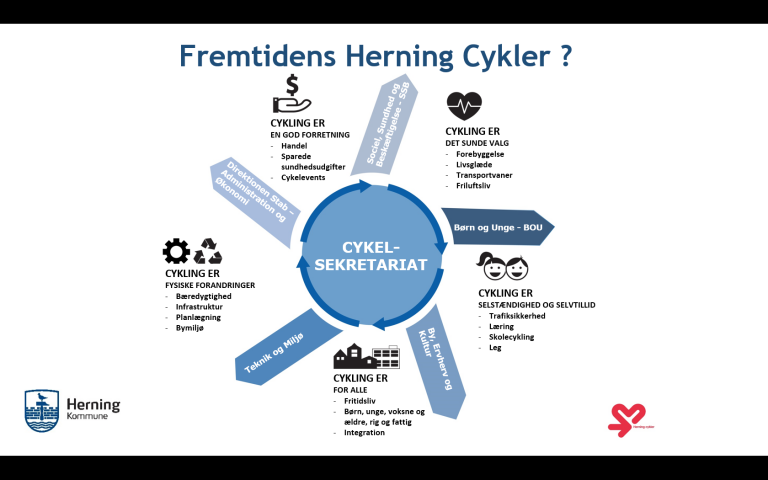
- Illustration from the Municipality of Herning of how bicycle promotion can be integrated into the municipality’s different administrations and boost visions and objectives. The bicycle secretariat relates to the departments of Health, Social services and employment, Children and Youth, Urban and economic development, and culture, Traffic and the environment as well as Management: HR, administration, and finance. CYCLING IS GOOD BUSINESS – Commerce – Saved public health costs – Cycling events CYCLING IS THE HEALTHY CHOICE – Prevention – Quality of life – Transport habits – Outdoor activities CYCLING IS INDEPENDENCE AND SELF- CONFIDENCE – Traffic safety – Learning – School cycling – Games CYCLING IS FOR EVERYONE – Leisure activities – Children, young people, adults and seniors, rich and poor – Integration CYCLING IS PHYSICAL CHANGES – Sustainability – Infrastructure – Planning – Urban environment
Create synergy by inter-departmental cooperation
Since cycling can help realize visions and objectives such as those shown above, it makes sense to establish good communication about bicycle planning across the municipal departments. Better cooperation means:
- Better outcomes when different interests cooperate from the start.
- All departments pull in the same direction and speak the same language.
- Resources are saved, both time and money, when allocations are pooled in a common fund with a joint aim.
Examples of relevant bicycle planning partners
In-house, within the municipal administration:
- Integration
- Children and young people (schools, daycare centers, after school care )
- Health department
- Social work department
- Culture and leisure
- Nature and the environment
- Business
- Planning department
- Tourism department
- Roads and traffic
External:
- Ordinary citizens
- Cyclist organizations’ local branch
- Senior citizens committees
- Disability councils and organizations
- Sports clubs, including mountain bike clubs
There can be many reasons why cooperation among the municipal departments and administrations does not always function optimally, and the interface is not clearly defined. This depends on the individual local authority and the individual department.
Barriers to cooperation on bicycle planning
Here is some good advice and examples of how to overcome the barriers:
- Busyness: Involvement and inter-departmental dialogue is a time consuming and occasionally strenuous process, and is sometimes given low priority.
- Finance: If the individual departments have not allocated funds to promote cycling, this may be an issue that is not addressed. Who pays for what can also be an issue.
- The interface is unclear: Who takes the lead in the cooperation? Who is responsible for ensuring that cycle planning is included as a cross-functional tool.
- Culture: Some local authorities have less of a tradition of inter-departmental cooperation than others. It can also vary from department to department.
- Insufficient knowledge of other departments and their field of work. Planners don’t know which is the right department or the right person to approach.
- Colleagues’ physical placement: Departments that should cooperate on bicycle planning are often not physically placed near each other. This may make cooperation difficult and increase the risk of forgetting the cooperation or giving it low priority on a busy working day.
How to create good cooperation
In order to exploit all the advantages cycling offers and ensure that cycling is used as a tool to achieve different aims and visions, it is essential to initiate concrete actions to boost the inter-departmental approach. Here are some good examples of how Danish local authorities are working to ensure the integration of bicycle planning into different inter-departmental contexts.
A concrete project as a lever
A concrete project can be a way of initiating cross-functional cooperation in order to ensure that knowledge sharing and cooperation become a natural element across the organization and with external partners.
In 2018 Silkeborg municipality initiated a project in connection with the respective construction of a new school and a new gym, and a new gym and a new nursery school at two different concrete locations.
Silkeborg municipality creates synergy and cohesion through a well-structured, involving process across organizational pillars, departmental funding, and between local activities when carrying out new construction in the local community.
The project also aimed at developing a concept for how to do it.
To ensure that all professional perspectives are involved in the iterative process, the organization is anchored across the seven relevant professional fields. Silkeborg municipality’s concept is called Development Concept for Portfolio Management (Udviklingskoncept for porteføljestyring) and is now used whenever new municipal buildings need to be placed.
In addition, the project has had the positive outcome that communication between the various departments has improved, and co-workers have gained greater understanding of other departments’ interests and issues.
Dedicated cycle coordinators or a bicycle secretariat
Since activities that are anchored in different administrations and organizations are often very different, it’s essential to clearly define the different roles and the interface. Initiatives to promote cycling often depend on a cycling enthusiast who is passionately engaged in cross-functional cooperation, and if this co-worker leaves the organization there is the risk that the cross-functional focus disappears too.
Consequently, a cycling coordinator or a bicycle secretariat might be a good idea in larger municipalities, as in the case of Rudersdal. The role of such a function is to ensure that bicycle planning is factored into the various professional groups’ work to achieve their goals, and ensure inter- departmental communication, thereby creating synergy. When this is explicitly stated as the purpose of the position of coordinator or the secretariat, cooperation among all professional groups is natural, and the coordinator doesn’t see himself as part of an individual administration separated from others. Several larger local authorities have appointed an anchor person for bicycle traffic.
Broad anchorage via ambassadors
A broad anchorage that includes making the potential of bicycle promotion visible is an excellent idea. A broad anchorage means both internally within the local authority and through external contacts. Some local authorities have cycling ambassadors, for example Randers. The ambassadors may be well-known local figures or merely passionate cycling enthusiasts who wish to make a positive difference in their local community. Herning has also used cycling ambassadors, for example someone involved in a bicycle club, or at a large workplace.
Bicycle action plans and mobility plans
Most Danish local authorities work with bicycle planning in some way, and many have a definite bicycle action plan or a mobility plan that includes bicycle planning. Citizens, business enterprises, and organizations should be involved from the start when drawing up the plan.
Citizen concerns, visions, general views, and concrete everyday experiences taken together with professional insight and overview is an excellent way of creating concrete, effective proposals for achieving the local authority’s visions and objectives.
Citizen involvement gives planners an excellent idea of what citizens want, and also helps create citizen ownership of the plan. Citizens are often good at thinking out of the box, which opens up the possibility of exciting, new and better projects. A strong local anchorage is essential from the start, and greatly increases the likelihood of successful cooperation.
The urban development department in Odense municipality has been highly successful in involving the other administrations in the City of Cyclists project (cyklisternes by). The starting point for cycling work is Odense municipality’s action plan for mobility and urban space 2017-2024. The action plan contains 50 different measures to support Odense municipality’s visions and objectives for traffic safety, mobility, health, urban development, commerce and growth, as well as Smart City. Many measures are carried out in a close cooperation with other administrations than the Urban Development Department, for example the Children and Young People department and the Elderly and Physically Disabled administration.
Frederiksberg municipality has also had good experience with broad involvement using the authority’s bicycle action plan 2016-2018. Focus group interviews and workshops were held for external and internal stakeholders. The broad anchorage can be seen in the fact that 15 out of 49 of the action plan’s activities have a project manager outside the technical and environmental administration.
For further information on how to give bicycle planning its own voice through bicycle plans or traffic and mobility plans, see: https://idekatalogforcykeltrafik.dk/en/planning-for-cycling-promotion/ in the present collection.
For further information on how bicycle planning can be integrated into municipal physical planning see: https://idekatalogforcykeltrafik.dk/en/cycling-as-an-integral-part-of-planning/ in the present collection.


